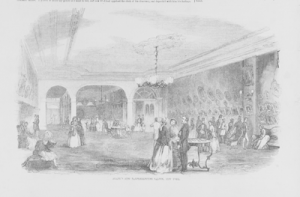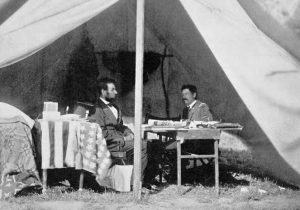Active Dates: 1844-1894 (?)
Gallerist: Mathew Brady (1822–1896)
Location:1All locations and dates from “Guide to the Mathew B. Brady Studio Portrait Photography Collection 1856-1869.” New York Historical Society Museum and Library. New York. 2011.
1844-1858: 205 Broadway at Fulton Street
1853-1860: 359 Broadway between White and Franklin Streets
1859-1860: 643 Broadway at Bleecker Street
1860- 1894 (?): 785 Broadway at Tenth Street (opened in 1860)
Specialty: The studio exhibited photographs, primarily portraits of American and European celebrities, and photographs taken during the American Civil War, including his own work.2Ann Shumard. “Antebellum Portraits by Mathew Brady.” National Portrait Gallery: Smithsonian Institution. Washington DC. His gallery spaces also acted as studio spaces and remained the province of daily studio sittings.3“Mathew Brady.” National Portrait Gallery, Smithsonian Institution. Washington DC.
Gallery History
Mathew Brady is most celebrated for his documentary photographs of the American Civil War.4Shumard. In 1844 he opened his first studio and gallery space in New York. Located at 205 Broadway and Fulton Street, this location was also referred to as the Daguerrian [sic] Miniature Gallery. It was the first commercial location to sell daguerreotypes (the first form of practical photography) and included a collection of Brady’s own work.5Shumard.
Brady’s brand expanded in 1853, when he opened his second studio down the street. New York’s Illustrated News advertised this new appointed gallery in June of 1853, stating that the space’s exhibition of Brady’s “large collection of daguerreotypes of imminent characters” was “well worth a visit from all who desire to witness American and European celebrities.” This collection included photographs from the US and abroad.6Shumard. Shortly after, Brady opened his third studio space at 643 Broadway and Bleecker which expanded beyond daguerreotypes and exhibited Brady’s new work, ambrotypes: “negative images on glass that appear positive when viewed against a dark background.”7Shumard. This new work soon exceeded the daguerreotype in popularity, and Brady was experimented further with this new medium. Ambrotypes became a focal point of his advertising, as it was a more durable and acceptable method of portraiture.8Shumard.
Brady’s three studios convened in 1860 at 785 Broadway and Tenth Street. He named this studio the National Portrait Gallery. In 1861, Brady, alongside a team of artists and photographs of Brady’s studio, left New York to photograph the American Civil War.9“Guide to the Mathew B. Brady Studio Portrait Photography Collection 1856-1869.” “The Dead of Antietam,” an exhibition showcasing these works, and the “first time the bodies of contemporary dead soldiers were seen by the general public,” opened in 1862. This exhibition was the most significant show in this space.10Julie L. Mellby. “Brady’s National Portrait Gallery.” Princeton University. 2009. This exhibition included portraits of Abraham Lincoln, and Union general Ulysses Grant. Photographs of the war were taken by Mathew Brady; Chas. Paxson, and W. Kurtz (owner of Kurtz Gallery) among others.11Melby.
Brady also opened and operated gallery spaces and studios in Washington DC. In 1858, he opened the National Photographic Art Gallery at 350-352 Pennsylvania Avenue, Washington DC. The studio was managed by Alexander Gardner, while Brady remained in New York.12“Mathew Brady’s World: A Biographical Timeline.” The National Portrait Gallery, Smithsonian Institution. Washington, DC. This location exhibited photographs of the Civil War and Brady’s portraits of famous patrons of the era. This gallery closed in 1881.13Historic American Buildings Survey, Creator. Mathew B. Brady Studio, 625 Pennsylvania Avenue Northwest, Washington, District of Columbia, DC. Documentation Compiled After. Photograph. Retrieved from the Library of Congress.
Illustrations





Date Written: April 18, 2020
Contributors: AB
Primary Sources
“Guide to the Mathew B. Brady Studio Portrait Photography Collection 1856-1869.”
New York Historical Society Museum and Library. New York. 2011.
Historic American Buildings Survey, Creator. Mathew B. Brady Studio, 625
Pennsylvania Avenue Northwest, Washington, District of Columbia, DC. Documentation Compiled After. Photograph. Retrieved from the Library of Congress.
“Mathew Brady.” National Portrait Gallery, Smithsonian Institution. Washington DC.
“Mathew Brady’s World: A Biographical Timeline.” The National Portrait Gallery, Smithsonian Institution. Washington, DC.
Mellby, Julie L.. “Brady’s National Portrait Gallery.” Princeton University. 2009.
Peeler, David P. “Review: Mathew Brady’s Portraits: Images as History, Photography as Art.” The Journal of American History.Vol. 85, No. 1. Oxford University Press. Jun., 1998. Pp. 170-173.
Shumard, Ann. “Antebellum Portraits by Mathew Brady.” National Portrait Gallery, Smithsonian Institution. Washington DC. https://npg.si.edu/exhibition/antebellum-portraits-mathew-brady
Secondary Sources
Brady’s New Daguerreotype Saloon, New York. 1853. National Portrait Gallery, Smithsonian Institution, Washington DC.
Brady’s Daguerreotypes (right). 1854. National Portrait Gallery, Smithsonian Institution. Gift of George S. Whiteley.
M.B. Brady at the World’s Fair in London. c. 1853. National Portrait Gallery Smithsonian Institution.
Brady, Mathew B.. Frederick W. Lander. c. 1857. National Portrait Gallery, Smithsonian Institution, Washington DC. Purchase Funded by the Photography Acquisitions Endowment Established by the Joseph L. and Emily K. Gidwitz Memorial Foundation.
Brady, Mathew B. John Pelham (right). 1858. National Portrait Gallery, Smithsonian Institution, Washington DC.
Unidentified Artist, Mathew B. Brady, 1823? – 15 Jan 1896. Mathew Brady Studio. C. 1861. Photograph, Albumen silver print. National Portrait Gallery, Smithsonian Institution, Washington DC.
